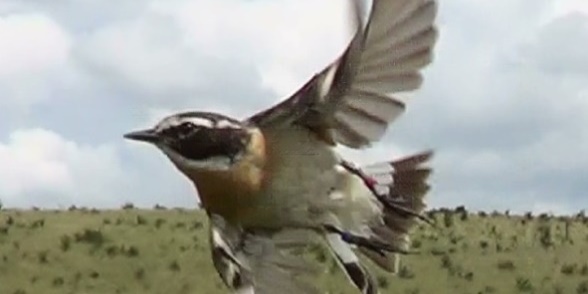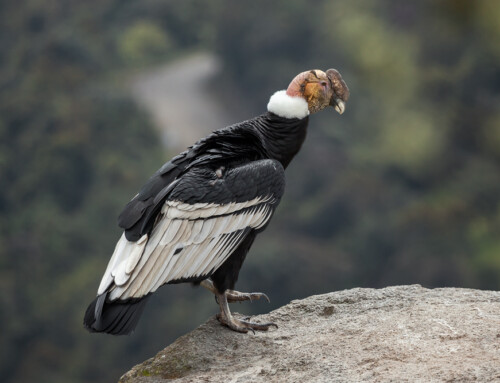Can large-scale data reflect fine-scale habitat preferences?
LINKED PAPER
Habitat selection by breeding Whinchats Saxicola rubetra at territory and landscape scales. Border, J., Henderson, I.G., Redhead, J.W. & Hartley, I.R. IBIS DOI: 10.1111/ibi.12433 VIEW
In order to efficiently focus conservation action we need to identify strongholds of habitat that still exist. Habitat preferences and areas of suitable habitat can be determined from fine-scale habitat sampling and corresponding surveys of species abundance (e.g. Pearce-Higgins & Grant 2006). However, this method is too expensive and time consuming to conduct over extensive areas or in very remote locations.
Due to advances in technology and large scale environmental monitoring there is an increasingly wide range of environmental data sets freely available (Elith et al. 2011). The corresponding increase in citizen science means species occurrence data is also now often available for large areas (Lepczyk et al. 2009). If we can use these data to model species distributions there is a potential to cover a much larger area for a fraction of the cost and time. However, this method assumes that habitat requirements determined for a species by intensive territory level surveys are transferable to the broader landscape scale, which is not always the case (Chalfoun & Martin 2007; Brambilla et al. 2009).
In order to explore the pros and cons of landscape scale data in more detail, we investigate habitat selection in breeding Whinchats, Saxicola rubetra. Whinchats are an Afro-palearctic migrant species which have suffered major and widespread declines in Europe over the last 50-60 years (EBCC 2012). Despite this, some local breeding populations buck the trend and have remained relatively strong and stable. One of these populations resides on Salisbury Plain in Wiltshire, southwest England. The habitat on Salisbury Plain has been protected from agricultural intensification due to its role as a military training ground and, currently, it is the largest area of unimproved grassland in northwest Europe (Ash et al. 2011; Fig. 1). The Whinchat population here is the only significant lowland Whinchat population remaining in England and one of the few in western Europe (Bastian & Feulner 2015). The persistence of this population suggests that fundamental breeding conditions still exist at this site and therefore it should be a good base to determine the natural habitat preferences of the Whinchat.

We investigated Whinchat habitat preferences at both the territory scale, using detailed field measurements (Fig. 2), and the landscape scale, using independently gathered remotely sensed and interpolated habitat data. We aimed to determine which habitat features were most strongly associated with Whinchat occurrence at each scale and to explore the consistency in preferences at the two scales.

Territory scale measurements revealed that Whinchats were mainly associated with valleys of long, structurally diverse tussock rich grasses and an abundance of perches. In general, landscape scale data yielded good estimates of areas of habitat suitable for Whinchats. However, due to the differences in how the data was measured and extrapolated, some responses differed for territory and landscape scales. This suggests that though landscape scale modelling can guide conservation action towards suitable regions, fine-scale measurements will still be needed to form reliable detailed management plans. We hope that by identifying the key habitat characteristics for Whinchats and investigating our ability to map suitable habitat at larger spatial scales this research may allow clearer interpretation of the causes of their decline and more effective conservation policies.
This work formed part of my PhD on investigating population limitations in breeding Whinchats (Taylor 2015). My data collection involved 3 field seasons living in a caravan near Salisbury Plain and as places to work go I think I struck pretty lucky. Salisbury Plain is beautiful and great for all kinds of wildlife from the endemic Fairy Shrimp to young Fox and Badger cubs, to soaring Hobbies and Short-eared Owls. It is also a unique site in another way: often a line of tanks would pass by while I was doing fieldwork or helicopters would hover low overhead. On one memorable occasion I looked up from sweep netting and suddenly noticed two camouflaged soldiers hiding in the grass only about 10m away and pointing a large gun in my direction. But the MOD were amazing to work with, they really supported the project and made every effort to help me fit field work around their training activities.

© Ian Henderson
The PhD is now finished but I am still involved with the Salisbury Plain Whinchats. This year we tagged 20 Whinchats with geolocators which was the first time any Whinchats have been tagged on their European breeding grounds (Fig. 3). We’re hoping the data we get back next year will help to determine where our Whinchats overwinter and the migration routes they take. This in turn will improve our understanding and enable better focusing of conservation action.
References
Ash, D. A., Swain, J. N. Wade, L. Etherington, H., Dawes, L. 2011. Salisbury Plain Nature Conservation Super Unit management Plans (SUMPs) 2010-2015. Defence Infrastructure Organisation.
Bastian, H-V & Feulner, J. eds. 2015. Living on the Edge of Extinction in Europe. Proc. 1st European Whinchat symposium. Helmbrechts, Germany: Landesbund für Vogelschutz / Kreisgruppe Hof.
Brambilla, M., Casale, F., Bergero, V., Crovetto, G. M., Falco, R., Negri, I. & Bogliani, G. 2009. GIS-models work well, but are not enough: Habitat preferences of Lanius collurio at multiple levels and conservation implications. Biol. Conserv. 142: 2033-2042. VIEW
Chalfoun, A. D., & Martin, T. E. 2007. Assessments of habitat preferences and quality depend on spatial scale and metrics of fitness. J. Appl. Ecol. 44: 983-992. VIEW
European Bird Census Council 2012. Whinchat (Saxicola rubetra). Available from: https://www.ebcc.info/index.php?ID=252. Last accessed 20th Feb 2015. VIEW
Elith, J., Phillips, S. J., Hastie, T., Dudik, M., Chee, Y. E. & Yates, C. J. 2011. A statistical explanation of Maxent for ecologists. Divers. Distrib. 17: 43-57. VIEW
Lepczyk, C. A., Boyle, O. D., Vargo, T. L., Gould, P., Jordan, R., Liebenberg, L., Masi, S., Mueller, W. P., Prysby, M. D. & Vaughan, H. 2009. Symposium 18: Citizen science in ecology: the intersection of research and education. Bull. Ecol. Soc. Am. 90: 308–317. VIEW
Pearce-Higgins, J. W. & Grant, M. C. 2006. Relationships between bird abundance and the composition and structure of moorland vegetation. Bird Study 53: 112-125. VIEW
Taylor, J. A. 2015. Determinants of variation in productivity, adult survival and recruitment in a declining migrant bird: the Whinchat, Saxicola rubetra. PhD Thesis. Lancaster University, Lancaster. VIEW
Image credit
Featured image: An adult male Whinchat in flight © Jenni Border
If you want to write about your research in #theBOUblog, then please see here.





